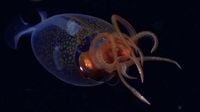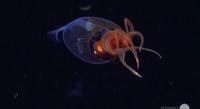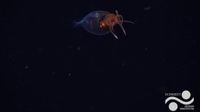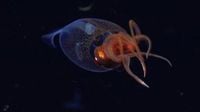In a remarkable breakthrough for marine biology, scientists have filmed a colossal squid alive for the first time in the depths of the ocean. This extraordinary footage, captured by the Schmidt Ocean Institute, showcases the elusive creature in its natural habitat, providing unprecedented insights into one of the ocean's most mysterious inhabitants.
The colossal squid, known scientifically as Mesonychoteuthis hamiltoni, is the largest invertebrate on the planet, capable of reaching lengths of up to 7 meters and weighing as much as 500 kilograms. However, the specimen filmed during the expedition was a young individual measuring only 30 centimeters.
On March 9, 2025, the groundbreaking encounter occurred near the South Sandwich Islands in the Southern Atlantic Ocean. The remotely operated vehicle (ROV) SuBastian, operated by the Schmidt Ocean Institute, was at a depth of 600 meters when it captured the astonishing video. This event marks a significant milestone, as adult colossal squids have been documented in the past only in a deceased state, often found in the stomachs of sperm whales or caught by fishermen.
Dr. Michelle Taylor, the chief scientist of the expedition from the University of Essex, described the footage as "amazing" and "beautiful," highlighting the importance of this discovery for understanding the species. The video not only confirms the existence of the colossal squid alive but also provides crucial data that could aid in the conservation and study of this enigmatic creature.
Prior to this momentous occasion, the existence of living colossal squids was largely a matter of speculation. The first specimens were only identified in 1925, based on stomach contents of hunted sperm whales. For nearly a century, these creatures have remained shrouded in mystery, with most encounters occurring through indirect observations or post-mortem examinations.
Marine biologist Kat Bolstad from the University of Technology in Auckland, who was consulted by the expedition team, expressed her excitement about the discovery. "It's thrilling to see the first in-situ footage of a young colossal squid. For a hundred years, we have encountered them mainly as prey found in the stomachs of whales and seabirds," she remarked.
The footage reveals the squid's semi-transparent body, adorned with eight orange arms and two long tentacles, all while emitting its own light in the dark depths of the ocean. This bioluminescence is a fascinating feature that helps the squid navigate its environment and possibly attract prey.
One of the distinguishing characteristics of the colossal squid is the presence of hooks on its arms, which are used to capture prey. Young squids exhibit a transparent appearance, but as they grow, they lose this quality. The video captured by SuBastian provides a unique opportunity to study the squid's anatomy and behavior in real-time, a feat that has never been accomplished before.
Bolstad further noted that the colossal squid possesses the largest eyes in the animal kingdom, comparable in size to a soccer ball. These large eyes are adapted for spotting predators like sperm whales in the dark ocean depths, showcasing the squid's evolutionary adaptations to its environment.
This groundbreaking observation is part of the international Ocean Census project, which aims to discover and catalog new marine species. The project highlights the importance of exploring the ocean's depths, where many unknown species may reside.
The colossal squid's habitat is primarily located in Antarctic waters, making it a unique subject for study. Unlike its more commonly known relative, the giant squid, which belongs to the genus Architeuthis, the colossal squid has distinct anatomical features and a specific ecological niche.
As scientists continue to analyze the footage and gather data from this expedition, the implications for marine research are vast. This first-ever live footage of a colossal squid opens up new avenues for understanding the biology, behavior, and conservation of this fascinating species.
In previous years, the largest colossal squid recorded was a female captured by a New Zealand fishing vessel in the Ross Sea, off Antarctica, in 2007. That squid was already dying when it was brought aboard, and although it provided valuable insights, it lacked the dynamic context that live footage can offer.
The excitement surrounding this discovery is palpable within the scientific community, as researchers reflect on the potential for future explorations. The ocean remains largely uncharted, with many species still awaiting discovery. The success of the Schmidt Ocean Institute's expedition serves as a reminder of the importance of ongoing marine research and the need to protect these vital ecosystems.
As the world grapples with the effects of climate change and ocean degradation, understanding the life forms that inhabit these waters becomes increasingly critical. The colossal squid's survival and the health of its ecosystem may provide key indicators of the overall health of the ocean.
In conclusion, the filming of the colossal squid alive for the first time represents a significant achievement in marine biology and conservation. It not only enriches our understanding of one of the ocean's largest and most enigmatic creatures but also underscores the importance of continued exploration and research in our oceans.





